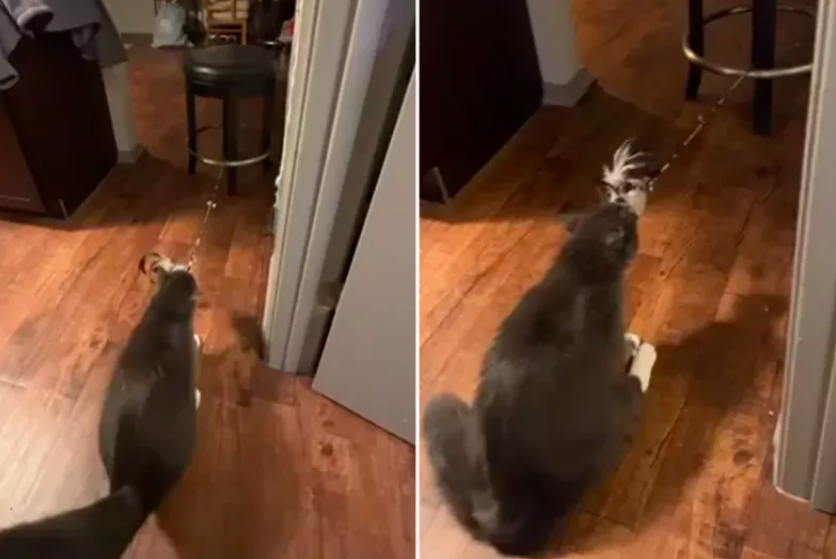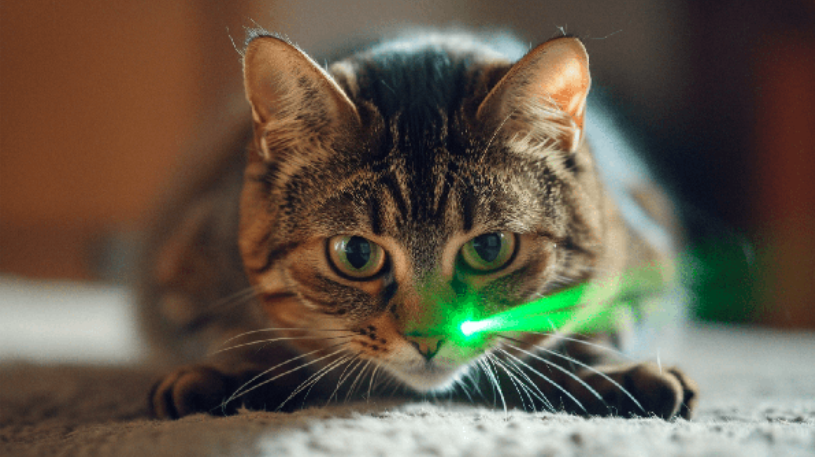Cats
How Frequently Does Rabies Occur In Cats? You Need To Find Out

How Frequently Does Rabies Occur In Cats? You Need To Find Out
The viral disease known as rabies has been around for thousands of years. It is a fatal viral infection of the neurological system that is highly contagious and can infect a wide variety of warm-blooded creatures, including humans, dogs, cats, and other animals.
Rabies is responsible for the deaths of more than 30,000 people worldwide every year. Rabies is a zoonotic disease, which simply means that it can be passed from animals to humans.
Rabies is a scary viral disease; it is necessary to know how it spreads and its symptoms, particularly if you have pets. It is especially important to know how it transmits from animals to humans.
If your cat has not been vaccinated against rabies, it can contract the disease from another animal infected with the virus and has bitten it. Regrettably, no treatment is now available for pets; however, a vaccine can provide protection.
If you recognize or observe the symptoms of rabies in cats, you can swiftly determine whether or not something is wrong with a cat you come into contact with.
This will allow you to know whether or not you should keep your distance from the cat.
What Exactly Is Rabies?
Disease prevention center: Centers for Disease Control and Prevention (CDC) state that rabies is a virus primarily passed on from diseased animal to human or animal to animal through biting.

These animals are typically wild animals that have not been immunized. Rabies is a gradual disease that affects both the peripheral and central nervous systems and always ends in death.
Rabies can be transmitted to cats by the bite of an infected animal. If an infected cat bites you, you run the risk of contracting rabies because of it.
Even though there is no treatment for rabies, there is a simple approach to keep your cat from getting it: Make sure his immunization against the disease is up to date.
What Does Cat Rabies Look Like?
A cat with rabies may display peculiar behavioral changes and specific physical symptoms. These are the things that you should keep an eye out for.
Behavior that is not typical
A sick cat may withdraw its affection or become particularly anxious and excited. Additionally, you might experience an increase in aggressiveness.
Drooling or frothing at the mouth may be present
The progression of rabies causes damage to the muscles that surround a cat’s mouth, which can lead to the cat drooling or foaming at the mouth.
Paralysis
Cats that are in the later stages of the infection could endure paralysis and then eventually fall into a coma before they pass away.
How Does The Rabies Virus Get Passed On To Cats
Rabies is most commonly spread through a cat’s bite once the cat has already been infected with the virus. Rabies can also be transmitted by the saliva of an infected cat, which is the second method of transmission.
The virus can survive outside the body in the saliva for up to two hours and infect other mammals if it comes into touch with a mucous membrane or an open wound.
Cats Showing Signs And Symptoms Of Rabies
After the initial bite that causes a cat to become infected, it might take up to a year for the animal to begin exhibiting symptoms of the disease. The following factors may determine the rate at which the symptoms of rabies appear:
The location where the infection is.
When a person gets bitten at a location closer to the brain and spinal cord, the virus can reach the neural tissues and begin causing symptoms much more quickly. The incubation period is prolonged proportionately to the distance between the incision and the brain.
The seriousness of the bite received.
In cats, the incubation period (the time between the infection and the development of clinical symptoms) is normally between 4 and 8 weeks; however, there is significant heterogeneity in this time frame.
The following are some of the signs and symptoms of the rabies virus:
- A sudden and drastic shift in conduct
- A previously hostile cat will eventually warm up to you, and vice versa.
- Anorexia, dread or anxiety, impatience, and hyperexcitability are all anxiety symptoms.
- A paralysis that has no known cause and seems to get worse with time.
- Seizures
- symptoms such as drooling, mouth saliva, and difficulty swallowing
There are three phases to the progression of rabies:
The prodromal stage is the initial 2 to 3 days of symptoms.
- Alteration in one’s personality or disposition
- When the larynx starts to spasm, a change in voice may be possible.
- Licking or scratching the bite that initiated the infection may have contributed to its spread.
- Cats that were previously calm become disturbed and perhaps violent.
- Even outgoing cats might have a reserved or anxious demeanor.
The Exciting or Furious Stage is the next is 1 to 7 days
- This period is referred to as the “crazy dog” stage.
- Do not be afraid, and you may have an illusion (when a rabid cat poses the greatest danger to humans and other animals)
- becoming more nervous, irritated, and violent by the minute
- If the rabid cat is confined, it will frequently try to bite through the cage’s bars.
The Paralytic Stage is the final stage, which is 2 to 4 days
- A state of weakness and paralysis sets in.
- Because of the paralysis of the larynx, the cat is unable to swallow, which results in excessive drooling and foaming at the mouth.
- When the muscles that govern respiration progressively become paralyzed, it only takes a few hours for a person to pass away.
Rabies is difficult to diagnose in living animals because its early stages are often confused with those of another disease or with aggressive tendencies in general.
This makes the disease difficult to detect. Examining the brain of the animal that has passed away is the only way to establish whether or not the rabies virus was present.
How Did My Cat Become Infected With Rabies?
Rabies is typically transmitted to cats by the bite of an already sick animal. The virus, carried in the victim’s saliva, enters the host’s tissues and attaches itself to the local muscles for a few days.
After that, it infiltrates the local nerves and begins its gradual ascent to the brain. At this stage, the virus is more detectable in all of the fluids produced by the body, including saliva.
The Process Of Identifying Rabies In Cats
It can be challenging to determine whether or not a cat has the rabies virus, particularly in regions where the disease is not usually prevalent.

It is now impossible to test for the virus in any animal still alive. Thus the only way to get a completely correct diagnosis is to examine the brain tissue of an animal that has already passed away.
If rabies is suspected or a cat exhibiting rabies signs passes away unexpectedly, your veterinarian may recommend testing. There are a few general measures that should be taken:
- If a cat exhibits or develops any signs of rabies, the animal must be examined by a licensed veterinarian and reported to the local health department as soon as possible. It is extremely suggested that humane euthanasia be performed.
- Suppose an unvaccinated cat bites a person or another animal and the cat’s vaccination status is unknown. In that case, the cat should be confined for ten days and kept under observation at all times.
Once clinical signs of rabies have appeared, an infected cat can pass on the disease to another animal. Because the cat was not shedding the rabies virus at the time of the bite, the cat couldn’t have transmitted the disease through the bite.
If the cat is still much alive or is not showing any clinical symptoms of rabies after the 10-day period of observation, then the bite could not have transmitted the disease.
If your cat is bitten by a wild animal or another stray cat, you should keep the cat indoors for six months. Suppose your cat is not vaccinated and was bitten by an animal highly suspected of having rabies.
In that case, the health department or animal control may recommend that your cat be humanely put to sleep.
On the other hand, the course of action that will be advised will likely be a series of rabies vaccinations to avoid post-exposure infection, followed by a period of quarantine.
Rabies Prevention And Treatment For Cats
Sadly, no treatment is available for a cat that has been infected with rabies and is exhibiting symptoms of the disease.
Seek emergency medical attention if you or your cat have been bitten by an animal that is thought to have rabies, and there is a possibility that the rabies virus has been transmitted to you or your cat.
To reiterate, there is no treatment available once the symptoms of the infection begin to appear. If your cat has been bitten, then your veterinarian might perform one or more of the following preventative measures:
Medication. A cat who may have been exposed to the rabies virus may be recommended to receive one or more rabies vaccinations.
In addition, the risk of infection can be reduced by immediately disinfecting any bite wounds that have been sustained. However, you should never try cleaning or disinfecting wounds at home without consulting a veterinary professional.
Booster. Vaccinated cats receive a booster vaccine, and depending on the area’s rules, they may be required to remain in quarantine for a predetermined amount of time. You should discuss the possibility of a home quarantine with your veterinarian.
Humane euthanasia. The most popular recommendation by veterinarians for cats whose rabies vaccination status is not up to date and who are likely exposed to infection is to have them compassionately put to sleep.
Suppose an owner refuses to have their animal put to sleep, and the local health authority or animal control allows it. In that case, the animal will be placed under a stringent and protracted quarantine that will often last for at least six months or more.
The following are some of the typical requirements for a home quarantine:
- The cat should only interact with one or two humans (and no children or other animals, even other pets).
- It is important to restrict the cat’s access to the outside world by housing it in an enclosed space.
- Quickly notify your veterinarian as soon as possible if you see any strange behavior in your cat or if it bites a person or another animal.
Cats that have not been vaccinated and bitten by wild animals or that exhibit evidence of being bitten by an animal of unknown origin must spend six months in isolation.
The incubation period for rabies is typically less than six months (generally four to six weeks, but it can be as long as six months), so a long isolation period is put in place to ensure that the cat does contact rabies before it is allowed to have regular contact with people and other animals once more.
Is there Any Treatment For Rabies That Can Be Given To Cats?
Once the symptoms of rabies have appeared, no treatment can reverse the effects of the disease. A vaccination that is given to your cat after it has been bitten, has the potential to protect it from developing rabies.
Is Rabies That Affects Cats Contagious To People Or Other Animals?
When an infected animal bites a human or another animal, there is a risk of contracting the disease known as rabies.
Rabies infection is most likely to occur in cats that have not been vaccinated, especially domestic house cats that are let to roam freely outside the home.
How Much Does It Cost To Treat Rabies In Cats?
There is no set price for the treatment of rabies in cats. Consider the following factors:
- Your geographical location.
- The expense associated with the vaccination itself
- The cost of the visit to the office
If you are ordered to put your cat into quarantine, you will be charged a fee every day the animal is locked up. If you fail to vaccinate your cat as required by the legislation in your area, you may be subject to a fine.
Recovery From Rabies And Management Of The Rabies In Cats
If a wild animal that cannot be tested bites a cat, it is reasonable to assume that it has been exposed to rabies.
Any unvaccinated cat that has been exposed to rabies should be terminated as soon as possible in a humane manner, according to the National Association of State Public Health Veterinarians.
Suppose the owner is unwilling to have the cat put down. In that case, the cat must be quarantined for six months, during which it cannot come into contact with other animals or humans.
It must receive vaccinations one month before the conclusion of the isolation period.
Even if the cat that was exposed had a current rabies vaccination, it should still be revaccinated right away and monitored for 45 days to ensure that it does not develop rabies.
The World Health Organization (WHO) has established stringent standards to restrict the spread of rabies among dog populations, and these guidelines are also applicable to cat populations.
These guidelines consist of the following:
- Notification to the relevant health authorities of any suspected cases
- Euthanasia in a humane manner of animals that are showing symptoms of the disease or have been bitten by animals that are suspected of having rabies
- The use of quarantine to reduce interaction between animals at risk
- Immunization programs that incorporate ongoing booster shots
- Elimination of stray animals
Preventing The Risk Of Rabies In Cats
There are a few different preventative measures that you may do to help keep your cat safe from rabies.
- Make sure your cat is vaccinated and that you are up-to-date on its future rabies shots, as well as schedule frequent appointments with your veterinarian. It is important to check with your veterinarian regularly to ensure that your cat’s rabies vaccinations are up to date. The frequency with which states mandate rabies vaccinations for cats might vary.
- If at all feasible, you should keep your cat indoors and keep an eye on it. Rabies is more likely to be transmitted to outdoor cats because they are more likely to come into contact with wild animals.
- Your contribution to reducing the overpopulation of cats can be maximized by having your pet spayed or neutered.
- If you find stray animals wandering around the area, you should report them to animal control since they may be sick or have not been vaccinated, making them a possible risk to your pet.
- If you come across any wild creatures that are acting unusually tame, you should get in touch with animal control (particularly raccoons, foxes, or skunks). Rabies is commonly diagnosed when normally timid wild animals display an absence of fear. You are not allowed to pet, stroke, or engage in any other interaction with these creatures, no matter how cute they may be. Although rabbits and other rodents (such as squirrels, mice, and rats) seldom contract rabies, they can carry other diseases transferable to humans, dogs, and cats. Rabies is a fatal disease.
- Because bats frequently carry rabies, you should never handle or pick up a bat under any circumstances. You should immediately contact your local veterinarian if you discover your cat interacting with a bat, whether alive or dead.
Vaccination is the most effective method we have for avoiding rabies.
The United States Department of Agriculture and wildlife services came up with the idea to create the National Rabies Management Program to try to stop the spread of rabies among wild animals and, eventually, get rid of the disease that affects humans on land in the United States.
The program will focus on vaccinating wild animals against rabies through oral vaccine administration.
How Often Do Cats Suffer From Rabies?
Although rabies in cats is not as common as it once was, it is vital to be aware of the signs if you come into contact with an infected cat.
According to the CDC, approximately 250 cases of rabid cats are reported each year. The vast majority of those cats have not been vaccinated, and as a result, they have contracted rabies by coming into contact with wild animals like raccoons and skunks.
How Long Before The Symptoms Of Rabies Appear In Cats?
The incubation period for rabies in cats can last anywhere from two weeks to many months; in some cases, it might even last for years.
The only test that can detect rabies involves a sample taken from the brain of a deceased animal; unfortunately, there is no technique to test a living animal for the disease.
What To Do In Case Your Cat’s Bitten
If you believe another animal has bitten your cat, you should contact your veterinarian as soon as possible.
Your veterinarian may treat the wound and give your cat a booster shot of his rabies vaccine to further improve his defenses against the virus.
Suppose your cat has never received a rabies vaccination in the past but is known to have been bitten by a rabid animal.
In that case, your veterinarian may suggest euthanizing your cat or confining him in a quarantine facility for several months to determine whether or not your cat has become infected with the disease.
Rabies is not usually transmitted through a bite because the virus is not always present in the saliva of an infected animal. If, on the other hand, your cat begins to show signs of illness, it is very guaranteed that he will pass away.
Your veterinarian may recommend euthanizing your cat to save the animal any further pain and ensure the well-being of the people in your home.
If you are bitten by any animal which might be infected with rabies, it is critical that you quickly wash the wound and contact a medical professional.
Your physician may advise you to undergo postexposure prophylaxis, which entails receiving several rabies shots in succession.
Is There A Rabies Vaccine For Cats?
Rabies may be prevented with a vaccine, which is why it is required in most states for cats that are kept as pets.
The immunization is administered to kittens between the ages of 12 and 20 weeks (the minimum age for rabies vaccination varies from state to state, so always check with your veterinarian).
After one year has passed since the initial vaccination, a booster dose is given. Afterward, booster shots are administered anywhere from once to every three years, depending on the type of vaccination that was administered and the laws of your state.
Even while immunizations have significantly reduced the frequency of rabies cases in cats, unprotected strays continue to be a danger to other animals and people.
Rabies is a lethal disease that can be transmitted both by wild animals and by domestic pets that have not been vaccinated.
Keeping your cat’s immunizations and booster shots up to date is the most effective way to avoid rabies, which is a fortunate development given that there is currently no treatment available for the disease after it has been infected.
Ensure That All Your Pets’ Vaccines Are Up To Date
Rabies vaccinations must be administered to cats and dogs belonging to owners in most states. Because the regulations can differ, it is important to verify with your vet.
In addition, getting your pet vaccinated is a requirement at most boarding and grooming establishments.
The rabies vaccines are completely risk-free and effective, and there is no possibility that your cat will become infected with rabies as a direct result of receiving one of these shots.
Although infrequent, modest adverse effects like drowsiness and appetite suppression may occur, they are very temporary in most cases.
Vaccinations are necessary to ensure the well-being and protection of your cat. If you have difficulties affording the rabies vaccination for your cat, then talk to your veterinarian about your options.
It is possible to receive financial aid, and most animal shelters in the area host free rabies vaccination clinics open to the general public.
We appreciate you for taking the time to read this article!
Finally, we hope you found this article interesting? And what do you think about ”How Frequently Does Rabies Occur In Cats? You Need To Find Out!?”
Please you should feel free to share or inform your friends about this article and this site, thanks!
And let us know if you observe something that isn’t quite right.
Cats
Clever Cats: Breeds That Learn Fast

Clever Cats: Breeds That Learn Fast
Cats have always fascinated us with their agility, independence, and sometimes enigmatic behavior. Among the vast array of feline breeds, some stand out for their remarkable intelligence and ability to learn quickly.
In this article, we will delve into the world of these exceptional cat breeds, exploring their unique characteristics, training capabilities, and what makes them such quick learners.
Whether you’re a seasoned cat owner or considering adopting a new feline friend, this comprehensive guide will help you understand the breeds that are not only intelligent but also a joy to train.
Why Intelligence Matters in Cats
Understanding Feline Intelligence
Feline intelligence is a multi-faceted trait that encompasses problem-solving abilities, social learning, and adaptability. Unlike dogs, cats often showcase their intelligence in more subtle ways, such as manipulating objects to get what they want or learning routines and commands.
Benefits of Owning Intelligent Cats
Owning an intelligent cat comes with several benefits. These cats are more interactive and engaging, making them excellent companions. They can learn tricks, follow commands, and even understand basic household rules, which makes living with them more enjoyable and less challenging.
Top Cat Breeds Known for Their Intelligence
Abyssinian

Overview
The Abyssinian is often hailed as one of the smartest cat breeds. Known for their curiosity and playful nature, Abyssinians are quick learners who thrive on mental stimulation.
Training and Activities
Abyssinians are highly trainable and enjoy interactive toys and puzzle feeders. They can learn tricks such as fetching and even walking on a leash. Their love for heights means they appreciate cat trees and climbing structures.
Siamese

Overview
Siamese cats are not only intelligent but also highly vocal and sociable. They form strong bonds with their owners and are always eager to engage in activities.
Training and Activities
Siamese cats are quick to learn tricks and commands. They enjoy interactive play and can be trained to perform simple tasks like opening doors or retrieving items. Their vocal nature also makes them responsive to verbal cues.
Bengal

Overview
Bengals are known for their striking appearance and high energy levels. Their intelligence is reflected in their ability to solve problems and learn complex tasks.
Training and Activities
Bengals enjoy activities that challenge their minds, such as agility courses and puzzle toys. They can be trained to walk on a leash and perform tricks. Providing them with interactive playtime helps in channeling their energy positively.
Burmese

Overview
Burmese cats are affectionate, people-oriented, and intelligent. They enjoy being involved in family activities and can be trained to follow various commands.
Training and Activities
Burmese cats are quick learners and respond well to positive reinforcement. They enjoy learning tricks, playing fetch, and interactive games that stimulate their minds.
Scottish Fold

Overview
Scottish Folds are known for their distinctive folded ears and sweet demeanor. Despite their calm appearance, they are intelligent and can learn quickly.
Training and Activities
Scottish Folds enjoy interactive toys and games. They can learn tricks and commands and appreciate routines that keep their minds engaged.
Training Tips for Intelligent Cats
Start Early
Begin training your cat as early as possible. Kittens are more receptive to learning new behaviors and routines.
Use Positive Reinforcement
Reward your cat with treats, praise, or playtime whenever they successfully perform a desired behavior. Positive reinforcement strengthens the association between the action and the reward.
Keep Sessions Short and Fun
Cats have shorter attention spans than dogs, so keep training sessions brief and enjoyable. Incorporate playtime to make learning fun for your cat.
Be Patient and Consistent
Patience and consistency are key when training cats. Repeat commands and routines regularly, and avoid punishing your cat for mistakes. Consistency helps reinforce learning and builds trust.
Challenges of Training Intelligent Cats
Independence and Stubbornness
Intelligent cats can sometimes be independent and stubborn. They might choose to ignore commands if they are not in the mood, so it’s important to understand their behavior and work with it.
Need for Mental Stimulation
Highly intelligent cats require constant mental stimulation. Boredom can lead to behavioral issues, so ensure they have plenty of toys, activities, and interaction to keep their minds engaged.
Managing High Energy Levels
Breeds like Bengals have high energy levels that need to be managed. Providing them with enough physical and mental exercise is crucial to prevent destructive behavior.
Living with Intelligent Cats
Creating an Enriched Environment
An enriched environment is essential for intelligent cats. This includes a variety of toys, climbing structures, scratching posts, and interactive feeders to keep them stimulated.
Social Interaction
Intelligent cats thrive on social interaction. Spend quality time playing, training, and simply bonding with your cat to ensure they feel valued and engaged.
Understanding Their Needs
Each intelligent breed has its own unique needs and preferences. Understanding these and catering to them will help you build a strong and positive relationship with your cat.
Conclusion
Owning an intelligent cat can be an incredibly rewarding experience. These quick learners bring joy, challenge, and companionship to their owners. By understanding their unique characteristics and providing the right environment and training, you can foster a deep and fulfilling relationship with your feline friend.
Whether you choose an Abyssinian, Siamese, Bengal, Burmese, or Scottish Fold, you’re sure to enjoy the remarkable intelligence and personality they bring into your home.
Frequently Asked Questions (FAQs)
What makes a cat breed intelligent?
Intelligent cat breeds often show high levels of problem-solving abilities, adaptability, and social learning. They can quickly learn commands, tricks, and routines.
Can all cats be trained?
While some breeds are more receptive to training than others, all cats can be trained to some extent. Patience, consistency, and positive reinforcement are key to successful training.
What are the best toys for intelligent cats?
Interactive toys, puzzle feeders, and climbing structures are ideal for intelligent cats. These toys provide mental stimulation and keep them engaged.
How do I keep my intelligent cat from getting bored?
Provide a variety of toys, engage in regular playtime, and introduce new activities regularly. Rotating toys and creating an enriched environment also help prevent boredom.
Are intelligent cats more difficult to care for?
Intelligent cats can be more demanding in terms of mental stimulation and interaction. However, with the right approach and environment, they can be delightful companions.
We appreciate you for taking the time to read this article!
Finally, we hope you found this article interesting? And what do you think about ”Clever Cats: Breeds That Learn Fast!?”
Please feel free to share or inform your friends about this article and this site, thanks!
And let us know if you observe something that isn’t quite right.
Cats
The Enchanting Scottish Fold: A Guide to the Adorable Feline with Folded Ears

The Enchanting Scottish Fold: A Guide to the Adorable Feline with Folded Ears
Welcome to the world of the Scottish Fold cat, where charm and curiosity meet in an irresistibly adorable package. With their distinctive folded ears and sweet expression, Scottish Folds have captured the hearts of cat lovers around the world. Originally hailing from Scotland, these cats are known for their gentle demeanor, playful nature, and loving personality.
In this comprehensive guide, we will delve into the fascinating world of Scottish Fold cats, exploring their history, physical characteristics, personality traits, and care requirements. Whether you’re a seasoned cat owner or considering adding a feline friend to your family, the Scottish Fold’s unique charm and affectionate nature make them a delightful addition to any home. Join us as we unravel the enchanting tale of the Scottish Fold cat and discover why they are such beloved companions.
Fold
Overview
The Scottish Fold cat is a charming and distinctive breed known for its unique folded ears and sweet expression. Originating from Scotland in the 1960s, these cats have captured the hearts of many with their endearing appearance and affectionate nature. Scottish Folds are known for their gentle and loving temperament, making them wonderful companions for families and individuals alike.
History and Origins
The Scottish Fold breed traces its roots back to a white barn cat named Susie, who was found in Scotland in the early 1960s. Susie had a unique genetic mutation that caused her ears to fold forward, giving her an owl-like appearance. This trait was passed down to her kittens, and thus, the Scottish Fold breed was born. The breed quickly gained popularity for its distinctive look and friendly demeanor, and it was officially recognized by cat registries in the 1970s.
Physical Characteristics
- Folded Ears: The most distinctive feature of the Scottish Fold is its folded ears, which give the cat a sweet and owl-like appearance. Not all Scottish Folds have folded ears; some may have straight ears, known as “straights,” which are also common in the breed.
- Coat and Colors: Scottish Folds can have either a short or long coat, both of which are dense and plush. They come in a variety of colors and patterns, including tabby, tortoiseshell, and solid colors like white, black, and blue.
- Body Structure: Scottish Folds are medium-sized cats with a rounded appearance. They have sturdy bodies, round faces, and large, expressive eyes that give them a sweet and gentle expression.
Personality and Behavior
Scottish Folds are known for their calm and laid-back demeanor. They are affectionate cats that enjoy being around people and are often described as “lap cats” due to their love of cuddling. They are also known for their playful nature and enjoy interactive toys and games. Scottish Folds are generally good with children and other pets, making them a great choice for families.

Health and Care
- Ear Care: Due to their folded ears, Scottish Folds may be prone to ear infections. It’s important to regularly check and clean their ears to prevent issues.
- Grooming: Scottish Folds have dense coats that require regular grooming to prevent matting and tangling. Weekly brushing is usually sufficient to keep their coat in good condition.
- Health Concerns: Scottish Folds are generally healthy, but they may be prone to certain genetic conditions, including a skeletal disorder known as osteochondrodysplasia. Responsible breeding practices can help minimize the risk of these health issues.
Training and Activities
Scottish Folds are intelligent cats that can be trained to perform tricks and commands. They enjoy interactive play and benefit from toys that stimulate their minds and bodies. Providing them with scratching posts and other outlets for their natural behaviors can help keep them happy and healthy.
Compatibility with Families and Other Pets
Scottish Folds are known for their gentle and affectionate nature, making them great companions for families. They are good with children and other pets, including dogs, and can adapt well to different environments. Their loving and sociable nature makes them a popular choice for households looking for a friendly and affectionate pet.
Conclusion
The Scottish Fold cat is a unique and charming breed known for its folded ears and sweet expression. With their gentle demeanor and affectionate nature, Scottish Folds make wonderful companions for families and individuals alike. Whether you’re looking for a lap cat to cuddle with or a playful friend to keep you entertained, the Scottish Fold cat is sure to bring joy and companionship to your home.
FAQs about Scottish Fold Cats
Why do Scottish Folds have folded ears?
Scottish Folds have a genetic mutation that affects the cartilage in their ears, causing them to fold forward. This unique trait gives them their distinctive appearance.
Are Scottish Folds prone to ear problems due to their folded ears?
Yes, Scottish Folds may be more prone to ear infections due to the fold in their ears, which can trap dirt and moisture. Regular cleaning and monitoring of their ears can help prevent issues.
Do Scottish Folds have any health issues associated with their folded ears?
Scottish Folds may be prone to a condition called osteochondrodysplasia, which affects the development of their cartilage and bones. Responsible breeding practices can help reduce the risk of this condition.
Are Scottish Folds good with children and other pets?
Scottish Folds are known for their gentle and friendly nature, making them good companions for families with children and other pets. They enjoy socializing and being part of the family.
Do Scottish Folds require a lot of grooming?
Scottish Folds have dense coats that require regular grooming to prevent matting and tangles. Weekly brushing is recommended to keep their coat in good condition.
We appreciate you for taking the time to read this article!
Finally, we hope you found this article interesting? And what do you think about ”The Enchanting Scottish Fold: A Guide to the Adorable Feline with Folded Ears!?”
Please feel free to share or inform your friends about this article and this site, thanks!
And let us know if you observe something that isn’t quite right.
Cats
The Enchanting Burmese Cat: Affectionate, Playful, and Loyal

The Enchanting Burmese Cat: Affectionate, Playful, and Loyal
Enter the world of the Burmese cat, where elegance meets affection in a charming feline companion. Originating from the temples of Burma, these cats have captured the hearts of cat lovers worldwide with their striking appearance and loving nature. With their sleek coats, expressive eyes, and playful demeanor, Burmese cats are not just pets; they are cherished members of the family.
In this comprehensive guide, we delve into the captivating world of Burmese cats, exploring their history, physical characteristics, personality traits, and care requirements. Whether you’re a seasoned cat owner or considering adding a feline friend to your family, the Burmese cat’s unique blend of beauty, intelligence, and affection is sure to captivate you. Join us as we unravel the enchanting tale of the Burmese cat and discover why they are such beloved companions.
Burmese
Overview
The Burmese cat is a breed known for its striking appearance and affectionate nature. Originating from Burma (now Myanmar), these cats are renowned for their sleek, muscular bodies, expressive eyes, and silky coats. Burmese cats are often described as “people-oriented,” as they form strong bonds with their human companions and enjoy being part of the family. Their playful and curious nature makes them delightful companions for both children and adults alike.
History and Origins
The history of the Burmese cat can be traced back to ancient Burma, where they were considered sacred and kept by monks in temples. They were later brought to the West in the early 20th century and quickly gained popularity for their striking appearance and affectionate personality. The breed has since become a favorite among cat enthusiasts worldwide, known for its loving and loyal nature.
Physical Characteristics
- Coat and Colors: Burmese cats have short, sleek coats that lie close to the body. They come in a variety of colors, including sable, champagne, blue, and platinum. The coat is soft and silky to the touch, adding to the breed’s overall charm.
- Body Structure: Burmese cats are medium-sized with a muscular build. They have rounded heads, large, expressive eyes, and short, straight noses. Their compact bodies give them a sturdy appearance, and they move with grace and agility.
- Eyes and Ears: Their eyes are one of their most striking features, being large, expressive, and usually a deep, rich color that complements their coat. Their ears are medium-sized, slightly rounded at the tips, and set wide apart on the head.
Personality and Behavior
Burmese cats are known for their affectionate and sociable nature. They are often described as “dog-like” due to their tendency to follow their owners around the house and seek out human companionship. They are also highly intelligent and enjoy interactive play, making them great companions for families with children or other pets.
In addition to their affectionate nature, Burmese cats are also known for their vocalizations. They have a soft, sweet voice that they use to communicate with their owners, often engaging in “conversations” and expressing their needs and desires.

Health and Care
- Grooming: Burmese cats have short coats that require minimal grooming. Weekly brushing is usually sufficient to remove loose hair and keep their coat shiny. They also benefit from regular dental care to prevent oral health issues.
- Diet: A high-quality, balanced diet is essential for maintaining the health and vitality of Burmese cats. They should be fed a diet that is appropriate for their age, size, and activity level to ensure they receive the nutrients they need.
- Health Concerns: Burmese cats are generally healthy, but they can be prone to certain genetic conditions such as hypertrophic cardiomyopathy (HCM) and diabetes. Regular veterinary check-ups and a healthy diet can help manage these risks.
Training and Activities
Burmese cats are intelligent and can be trained to perform various tricks and commands. They enjoy interactive play and thrive on mental stimulation. Providing them with toys, puzzle feeders, and opportunities for play can help keep them entertained and prevent boredom.
Compatibility with Families and Other Pets
Burmese cats are known for their loving and social nature, making them great companions for families. They get along well with children and other pets, including dogs, as long as they are properly introduced. Their affectionate demeanor and playful nature make them a popular choice for households looking for a friendly and engaging pet.
Conclusion
The Burmese cat is a breed beloved for its affectionate nature, striking appearance, and playful personality. Whether you are looking for a loyal companion or a playful friend, the Burmese cat is sure to bring joy and warmth to your home. With their loving nature and sociable demeanor, Burmese cats make wonderful pets for families and individuals alike, enriching their lives with their presence and affection.
FAQs about Burmese Cats
What is the temperament of a Burmese cat like?
Burmese cats are known for their affectionate and social nature. They are often described as “dog-like” due to their loyalty and tendency to follow their owners around the house. They enjoy being involved in family activities and form strong bonds with their human companions.
Are Burmese cats good with children and other pets?
Yes, Burmese cats are generally good with children and other pets. They are playful and enjoy interactive play, making them great companions for families with children. They also get along well with other pets, including dogs, especially if they are introduced properly.
Do Burmese cats require a lot of grooming?
Burmese cats have short, sleek coats that require minimal grooming. Weekly brushing is usually sufficient to remove loose hair and keep their coat shiny. They also benefit from regular dental care to prevent oral health issues.
Are Burmese cats vocal?
Burmese cats are known for their soft, sweet voice, but they are not excessively vocal. They use their voice to communicate with their owners, often engaging in “conversations” and expressing their needs and desires.
What kind of environment is best for a Burmese cat?
Burmese cats thrive in environments where they have plenty of opportunities for play and interaction. They enjoy being part of the family and should have access to toys, scratching posts, and other enrichment activities. They also enjoy having access to outdoor enclosures or safe outdoor spaces where they can explore and indulge their natural instincts.
We appreciate you for taking the time to read this article!
Finally, we hope you found this article interesting? And what do you think about ”The Enchanting Burmese Cat: Affectionate, Playful, and Loyal!?”
Please feel free to share or inform your friends about this article and this site, thanks!
And let us know if you observe something that isn’t quite right.
-

 Pet Care2 years ago
Pet Care2 years agoThe Best Dog Collars For 2022
-

 Dogs2 years ago
Dogs2 years agoBichon Frise: The Happy, Playful, and Cuddly Companion
-

 Trending Pet Stories1 year ago
Trending Pet Stories1 year ago2023 ‘World’s Ugliest Dog’ Winner: Scooter’s Tale of Resilience
-

 Animals2 years ago
Animals2 years agoAre There Animals Having Down Syndrome?
-

 Pets2 years ago
Pets2 years agoThe Fascinating World Of The Red Chameleon
-

 Dogs2 years ago
Dogs2 years agoTop 10 Most Popular Dog Breeds According To AKC.
-

 Dogs2 years ago
Dogs2 years ago21 Dog Breeds That Resemble Bears Or Teddy Bears!
-

 Dogs2 years ago
Dogs2 years agoEskimo Dogs from Canada – What Are They? – Find Out!













